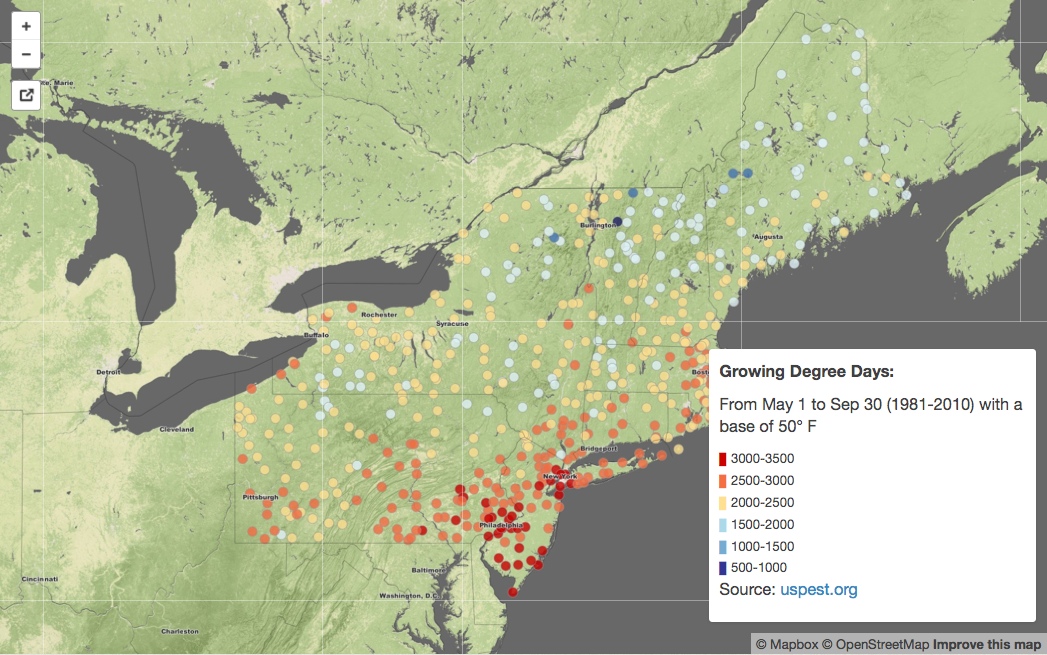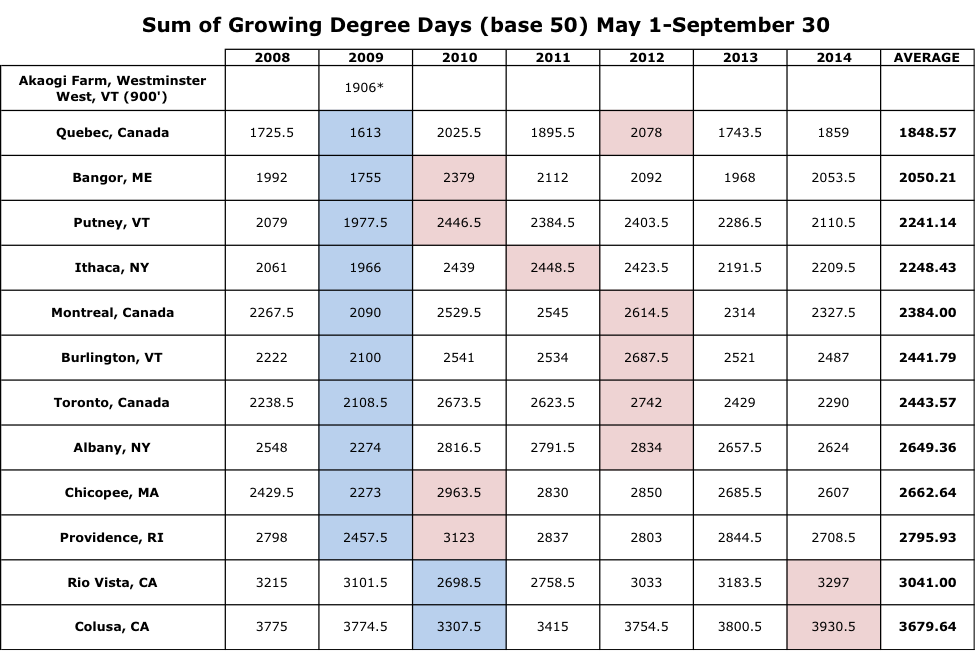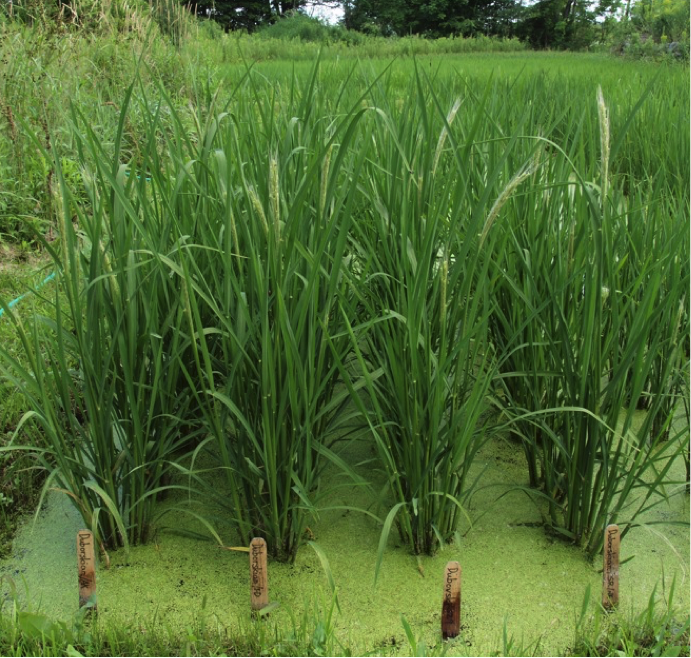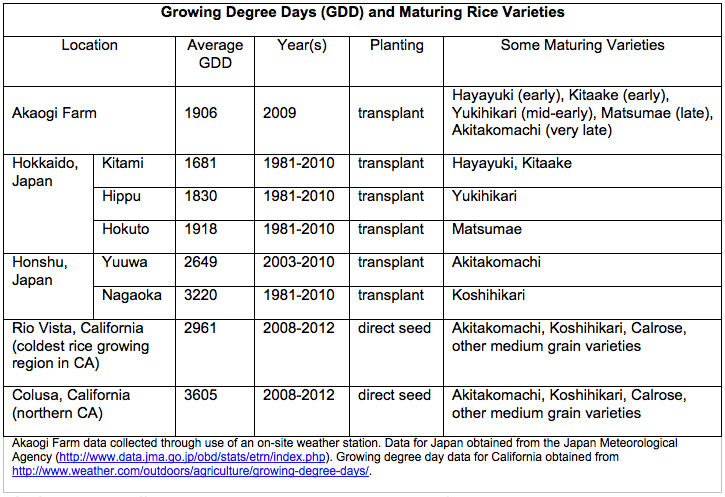Growing Degree Days
Download PDF version of this page
Climate in the Northeast varies greatly and has a significant impact on which rice varieties are able to mature in this cool region. Growing degree day data is a tool to help define climatic differences and identify rice varieties that are able to grow well in a specific location. The current growing degree day map will be improved with results from rice variety trials currently being conducted at around 30 sites throughout the northeastern USA.

What are growing degree days and how are they useful for rice growers in the northeastern USA
What are growing degree days, and how are they calculated?
Growing degree days (GDD), sometimes also called thermal days, are a unit of measure describing the amount of accumulated heat through the growing season. Temperature data from 1981 to 2010 was used to construct an interactive growing degree day map of the northeastern USA. Specifically, the calculation is done by adding the maximum and minimum temperature for a given day, dividing by two to obtain an average, and subtracting 50 degrees F (a common base point for GDD calculations.) Daily results were added from May 1 through September 30 (an approximate standard growing season for rice in the Northeast) for each year that data was available. In the final step to generate the map, data was averaged across the years.
GDD accumulated per day = [(Max. + Min. Temperature)/2] - 50 F. Sum over the growing season.
How do I read the growing degree day (GDD) map?
All locations reporting temperature data between 1981 and 2010 are marked with a colored circle based on the GDD range in which they fall. For the locations on the current map, average GDD values ranged from 500 to 3500 degrees above 50 F per growing season. Each 500-degree increment is marked with a different color, with the colors in a gradient from highest increment (3000 - 3500 = most degrees above 50 F, marked in red) to lowest (500 - 1000 = least degrees above 50 F, marked in blue).
If your exact location does not appear, moving east/west along the map to the closest reporting location (cross-check altitudes to be sure no major changes) will give you the most reasonable estimate, for average temperatures tend to change more quickly with elevation and latitude than with longitude.
How is the GDD map useful to me?
Growing degree days is a standard measure that is used for many crops to determine the degree of adaptation to a particular region, or whether a variety is likely to mature in a particular geographical zone. Because there is currently very little information about which varieties can mature in the Northeast's cold climate, comparing growing degree days with other temperate rice growing regions, including northern Japan and California, can be helpful. Once you have looked up the GDD value for your area, you can check the map and other existing resources from those regions to get a better idea of what varieties may work well in your fields. In general, it seems that growing degree days above ~1500 may allow many of the early varieties from Hokkaido to mature. Growing degree days above ~2500 may allow later-maturing varieties from Hokkaido and early-maturing varieties from California to mature and produce grain in the northeastern USA.
Why not use hardiness zones or heading dates?
Hardiness zones, constructed based on annual minimum temperatures, are helpful for many crops, particularly perennial crops that have to endure cold winter temperatures. In the case of rice in the Northeast, however, minimum winter temperatures do not appear to be the deciding factor in determining a variety's ability to mature. Given the short growing season and cool temperatures that characterize the northeastern region of the US, compared to much of the rest of the rice-growing world, the amount of heat and sunlight accumulated over the growing season has been observed to be a better predictor of varietal adaptation than hardiness zones.
Accumulated heat and light over the growing season are very important in determining both the maturity and final yield of a variety, for they both dramatically impact the plant's photosynthetic machinery. If it is too cold for the machinery to operate at maximum capacity, incoming solar energy will be dissipated by the plant as heat (to prevent damage from excess sunlight) rather than being used for biomass (green leaf and stem tissue) production. Similarly, if incoming sunlight is lower than what the plant can optimally use, photosynthetic activity won't be maximized and plant growth will be stunted and delayed. These and other aspects of a plant's response to temperature and light add up over the growing season-- one reason why GDD is a useful way to think about things--and over the course of an entire growing season, become key determinants of whether a plant achieves its full yield potential.
Heading dates of specific varieties may prove to be useful, and this data will be collected from farmers in the Northeast this year. However, heading dates are not as easily generalizable across regions as growing degree days, and given that no historical data are yet available, a few years of data on a range of different varieties will be needed to get enough points and years on the map--especially with the growing seasons varying as much in weather patterns as they have been.
Northeast Climate
Climate ranges across the Northeast and there is a distinctive difference in which types of rice varieties are able to mature between the northern/coldest regions, which also include marginal locations due to elevation or other microclimate influences, and the more southern areas. While the warmer regions of the Northeast (e.g. parts of New Jersey, Pennsylvania, and along the coast) are able to grow the cold-tolerant varieties from California, the colder, marginal climates are very limited to varieties that are not only cold-tolerant, but also early heading and early maturing. To visibly explain this range in climate, growing degree day (GDD) data was used to create a map of the Northeast Link. Growing degree days seems to be the best indication of which varieties are able to mature at a particular location because it takes into account cool daily temperatures within the rice growing season Link. Climate also varies from year to year and the Akaogis have noticed differences in which varieties of rice are able to mature at their location since they first started growing rice in 2007. For example, Akitakomachi, which tends to be a late maturing variety at Akaogi Farm, produced mature seeds in 2013 when GDD in nearby Putney, Vermont was 2286.5 but not in 2014 when GDD was 2110.5 (see Table 1). To test which rice varieties are able to mature and connect that information to GDD data, volunteers participated in trials during the 2014 growing season in exchange for seed (see Table 5).
Table 1. Growing degree day data for locations across the northeastern US, Canada, and northern California over the last several years with the coldest years indicated by a blue background and the warmest years indicated by a pink background.

* Data obtained from on-site weather monitoring station.
All other data obtained from http://www.yourweekendview.com/outlook/agriculture/growing-degree-days/.
Akaogi Farm Rice Trials
Since 2007, the Akaogis have trialed over 100 rice varieties from Japan, northern California, Korea, China, Russia, and Italy. These varieties have come from seed collections maintained by the USDA including the Genetic Stocks- Oryza (GSOR) and National Small Grains Collection (NSGC) and seeds imported from IRRI through Cornell University. A list of the varieties grown in 2014 can be found in Table 2 and Table 4.
Table 2. A list of rice varieties grown at Akaogi Farm in 2014 (in addition to the Chinese varieties listed in Table 4) organized by heading date with comments about performance.

Duborskian
Duborskian is a variety that was originally obtained from Professor John Peverly at Cornell Univeristy in 1983 by Christian Elwell of South River Miso Company. A complete explanation of the history of Duborskian can be found in Appendix A. During the 30-year period it has been grown by Christian Elwell, seed has spread to other growers across the country. As a result, both Fedco Seeds and Seed Savers Exchange distribute Duborskian and it has become the easiest seed to get for growers interested in a cold-tolerant, early-maturing rice variety. In descriptions of Duborskian from different sources, plant height ranged from around two feet to up to four feet. In order to get some clarity on whether or not these strains identified as Duborskian were the same, a side-by-side comparison was conducted at Akaogi Farm along with a variety from the USDA collections called Dubovskij 129 (see Figure 4). To distinguish Christian Elwells strain of Duborskian from others, it was named Duborskian-South River. This quick experiment seems to suggest that all of them are the same variety as there were no visible differences in morphology or heading date (see Table 2). Plant height for Duborskian seems to be influenced by environmental factors. This was further supported by data from our Northeast rice trials where plant height ranged at the different locations depending on climate and other unknown factors.
Figure 4. Photo of the different strains of Duborskian planted next to each other at Akaogi Farm on July 21, 2014.

Chinese varieties imported from IRRI
After Ruaraidh Sackville-Hamiltons attendance at the 2011 conference, he offered his services in identifying cold-tolerant, high elevation and northern China rice varieties from IRRIs seed bank. Around 80 varieties (see Table 3) were imported through Cornell University and went through the quarantine and grow-out process at the McCouch greenhouses in 2013. From the grow-out, 46 varieties were identified as having a relatively early heading date. Seed collected from these 46 varieties were sent to Akaogi Farm and grown in 2014.
Table 3. List of the 79 rice varieties imported from IRRI in 2013.

Table 4. List of Chinese rice varieties imported from IRRI and field-tested at Akaogi Farm in 2014 organized by heading date with comments about performance.

Of the 46 varieties field trialed at Akaogi Farm, 20 produced mature seed and will be planted again in the future. The varieties had a range of unique physical characteristics that make them a promising new source of genetic material for growers in the northeastern US.
As a result of their trials, the Akaogis have found that the varieties that are productive in their location need to be both cold-tolerant and early maturing. Some cold-tolerant varieties do not mature within the short growing season because of issues with photoperiod. For example, none of the high altitude Chinese varieties were able to mature in time even though they were considered cold tolerant (see Table 4). Early maturing varieties that require a small number of days to head have difficulty with the cool nights that are common during the growing season in the Northeast and do not produce seed. This may have been the case for some of the varieties tested at Akaogi Farm that had an early heading date but produced sterile seeds (see Table 2 and Table 4).
Northeast Rice Variety Trials
In 2014, rice variety trials were conducted with volunteer participants to gather more data about how climate (growing degree days) influences which varieties of rice are able to grow well and produce mature seed. Four varieties were chosen based on prior growing experience at Akaogi Farm and seed availability. These varieties ranged from early maturing to late maturing in the Northeast and included Yukihikari, Duborskian-South River, M-102, and Koshihikari. Yukihikari: early maturing, short grain glutinous rice variety from Hokkaido, Japan. Duborskian-South River: short grain rice variety originally from Ukraine that has been grown by Christian Elwell at South River Miso Company in Conway, MA for 30 years (see Appendix A). M-102: early maturing, medium grain variety from California. Koshihikari: late maturing, short grain rice from mainland Japan especially suited for sushi.
Out of the 27 people who signed up to receive seed, 14 were able to seed and grow rice plants. Prior knowledge about growing rice was not a prerequisite to participation in the rice trials and many had difficulties with inexperience, climate, and unpredictable weather events. Although, 2009 was undeniably the coldest year for many in the Northeast (see Table 1), 2014 was also a very cool year and many people (e.g. Ben Falk and Sjon Welters) had difficulty growing rice when they had success in prior years. A few participants, indicated by the asterisk, had growing degree days that should allow some rice varieties to produce mature seed but had difficulties as a result of other factors.
The 14 participants provided information about which varieties matured at their location and which were unable to produce seed . Many grew other varieties in addition to the variety panel chosen for this study and included information about these varieties as well. To relate this variety information to climate data, an online calculator was used to approximate growing degree days for each location.
As expected, Yukihikari and Duborskian-South River were able to produce seed in a wide range of climates. For some reason, Duborskian-South River was able to withstand the largest range of climates and growing conditions, while Yukihikari had difficulty producing seed in locations where it was expected to do well. Based on these results alone it may be concluded that Duborskian-South River is a good candidate for growers in the Northeast. However, this variety is susceptible to lodging when it grows tall (up to 4 feet tall in certain environments) and has long awns that deter birds but also make it difficult to process post-harvest. From several years of experience at Akaogi Farm, Yukihikari has proved to be most reliable and productive. Also as expected, Koshihikari did well in warmer regions of the Northeast where growing degree days were above 2200 (see Table 5). In these locations, Koshihikari would be a good option as it is a well-known, productive, short-grain rice that has commercial seed sources in California. M-102, was chosen as one of the early-maturing California varieties, but only produced mature seed in a few of the locations.
Five participants completed a Rice Farmer Observation Sheet with more detailed information about their growing practices and actual data about the 4 trial varieties . Days to heading seemed to decrease with warmer climate, however this data may have a greater factor of human error as this was the first time participants measured this parameter. M-102 seems to take longer to head than Koshihikari and a longer growing season than the Northeast climate can provide. At the moment, we have not found an 'early maturing, cold tolerant' variety developed in California that might do well in the warmer regions of the Northeast.
One anticipated result of the variety trials was to be able to identify a few varieties that would be good to amplify for a potential seed grower/distributor/company. The data demonstrates the complexity of growing rice successfully in the Northeast and that it is difficult to determine the best varieties based on one years data alone when there is such a range in climate across the region.
Over 80 different rice varieties have been evaluated for adaptation on the Akaogi Farm in southeastern Vermont, and varieties from Hokkaido are the top performers. For more information about the varieties trialed at Akaogi Farm in 2008 and 2009 please refer to the Northeast SARE grant reports.
Table 5

Summary
We recommend using GDD, a measure of accumulated heat over the growing season, as a guiding metric when deciding which varieties to plant in a given geographical region. In review, the GDD metric accomplishes the following:
1) Summarizes accumulated temperatures (heat) throughout the entire crop growing season in a single number. Hardiness zones are based on minimum annual temperatures, which more than likely (hopefully) fall outside of the rice growing season.
2) Connects us with the global rice community and its established resources, especially useful for helping to identify suitable varieties for the northeastern USA. Allows us to learn from learn from the past field seasons of farmers working in similar microclimates (hopefully saving time, money, and effort).
3) Successfully predicted that modern Hokkaido varieties would perform best on the Akaogi Farm, likely because it incorporates aspects of rice maturation that are especially important in cold climates and are difficult to discern.
4) Appears to be a reliable measure for the climatic factors most important to rice varieties' viability and productivity in the northeastern USA.
5) Contributes information about new varietial diversity for the Northeast rice community and possibly funds new favorite varieties along the way!